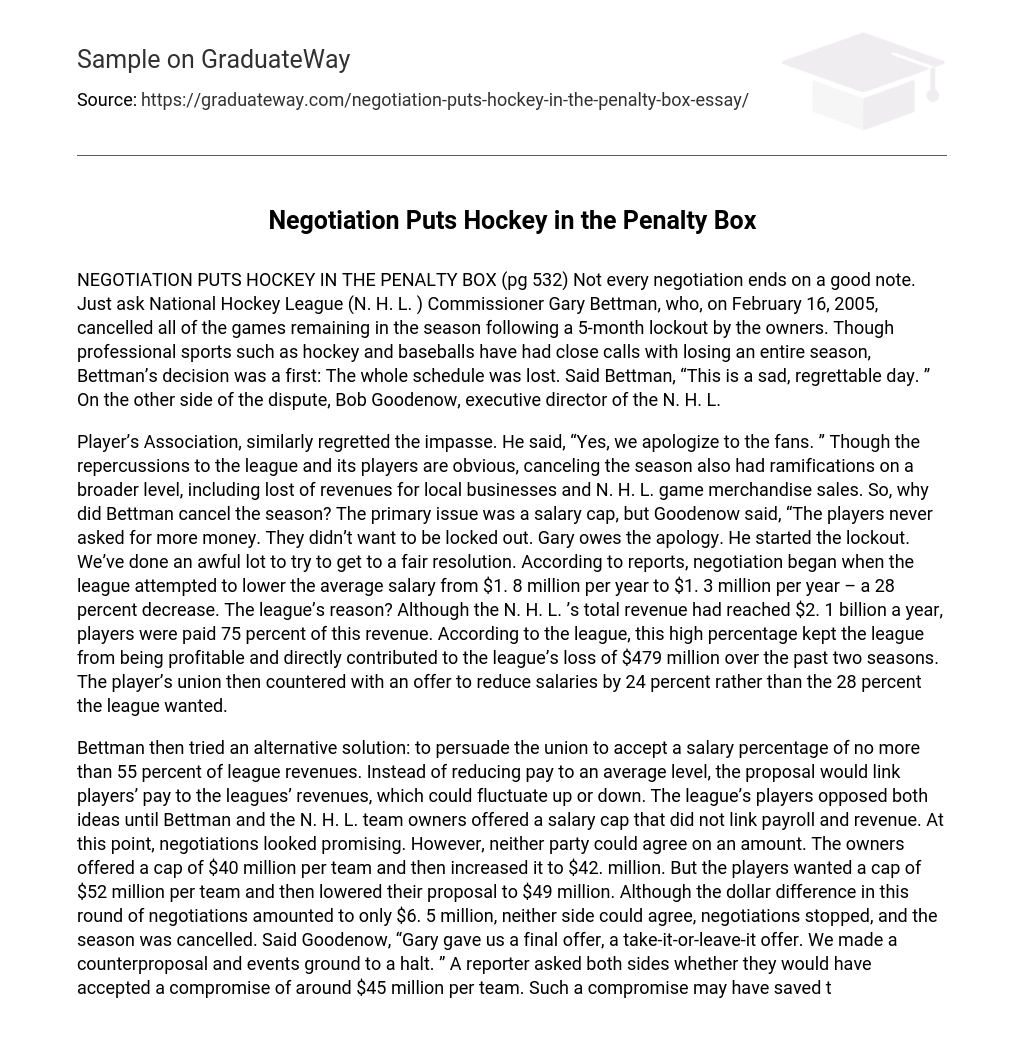NEGOTIATION PUTS HOCKEY IN THE PENALTY BOX (pg 532) Not every negotiation ends positively as National Hockey League (N.H.L.) Commissioner Gary Bettman discovered on February 16, 2005. He had to cancel all remaining games of the season due to a lockout initiated by the owners that lasted for 5 months. While other professional sports like hockey and baseball have faced the possibility of losing entire seasons, Bettman’s decision was unprecedented – it wiped out the entire schedule. “This is a sad, regrettable day,” lamented Bettman in expressing his disappointment. On the opposing side of this conflict stood Bob Goodenow, the executive director of the N.H.L.
The Player’s Association has expressed regret and apologized for the impasse, acknowledging the impact of the season cancellation on various aspects including the league, players, local businesses, and NHL merchandise sales. The decision to cancel was primarily due to a salary cap issue. It is important to note that the players did not demand more money or desire a lockout. Gary is responsible for the lockout; however, efforts have been made to achieve a fair resolution. Negotiations began when the league aimed to decrease average salaries from $1.8 million per year to $1.3 million per year (a 28 percent decrease). This decision was justified by citing that players received 75 percent of the NHL’s total revenue, which amounted to $2.1 billion annually. Reports indicate that this high percentage hindered profitability and resulted in a loss of $479 million over two seasons. In response, the player’s union proposed a 24 percent reduction in salaries instead of the desired 28 percent decrease proposed by the league.
Bettman aimed to persuade the union to agree on a maximum salary percentage of 55% of league revenues as an alternative to reducing pay to an average level. This proposition would link players’ salaries with the fluctuating revenues of the leagues. Initially, the players opposed both ideas until Bettman and NHL team owners introduced a salary cap that didn’t correlate payroll with revenue. At this point, negotiations seemed promising, but they couldn’t reach consensus on the specific amount.
The owners offered a $40 million per team cap initially, which later increased to $42 million. However, the players desired a $52 million per team cap and subsequently decreased their proposal to $49 million. Although the dollar difference in this round of negotiations was only $6.5 million, neither side could find common ground, leading negotiations to come to a halt and resulting in the cancellation of the season.
Goodenow claimed that Bettman presented a final offer that was take-it-or-leave-it, and when the players countered it, everything came to a standstill. Both sides were asked if they would have accepted a compromise around $45 million per team, potentially saving the season.
Bettman emphasized the importance of clear communication, stating that if the players desired $45 million, they should have communicated their wishes to us, even if we might not have agreed. In contrast, Goodenow avoided speculation and considered discussing hypothetical scenarios unproductive. Eventually, both parties resolved the situation by reaching a six-year agreement. This agreement established a salary cap of $39 million per team for the 2005-2006 season (it’s worth noting that initially the players sought a cap of $49 million). Although many players were dissatisfied with the terms of this agreement, they recognized that opposing the salary cap was futile and only served to alienate the fans.
Goodenow faced opposition from players who believed he had put them in an unwinnable position. However, despite denying that his resignation was a result of player complaints, Goodenow stepped down as executive director of the N.H.L. Player’s Association within a week after the lockout ended. The failure to reach an agreement in N.H.L. negotiations affected various stakeholders, including the league, affiliated businesses, owners, players, and fans.
— Organizational Behavior – II Term Paper Submitted to: Prof. Bijaya Mishra
Submitted by: Sareeta Patnaik
Roll No. U407044 ExPGP NR 07-10





